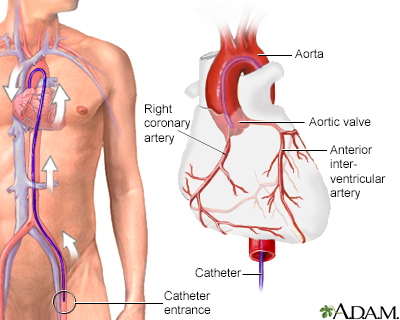
Angiography
Introduction
The purpose of this tool is to help you decide whether or not to have an angiography. When making a decision like this, you must balance:
- The reasons for having the test
- The potential health risks, drawbacks, or limitations of the procedure
- Whether there are alternative procedures that may be more appropriate
- Cost
This tool is not a substitute for professional medical care and advice. Work with your doctor to help you make this decision. A second opinion from another doctor may be valuable. There is usually no exact “right” or “wrong” answer.
Your physician may make certain recommendations to you. However, the final decision about whether to have this test rests with you.
What is the test?
Arteriography (also known as angiography, angiogram, or arteriogram) is a procedure in which a contrast material (dye) is injected through a catheter into one of the arteries. The dye is viewable using x-ray equipment, allowing your health care provider to see the vessel.

In general, angiograms provide the best pictures of the body's blood vessels. Angiograms help doctors make specific diagnoses and determine the best treatment for your case. Often, your health care provider can perform treatment through the same type of catheters used in the angiogram. This can eliminate the need for more invasive procedures, such as surgery.
An angiogram can be used to confirm a stroke or to look for blood clots in the legs and lungs. This tool will discuss having an angiogram to look for heart problems.
Key points
- This test can show if arteries are blocked and the location of the blockage.
- The test is performed under light sedation.
- The risks of this test increase with age and in patients who have other medical problems, such as kidney disease or blood flow problems in other parts of their body.
- There is a small risk of bleeding, infection, and pain at the catheter site.
- The major risks are heart attack, stroke, and death.
How much time this decision tool will take
5 - 10 minutes
What this tool will provide
- A personalized list of factors for you to weigh
- Questions to ask your doctor
- Alternatives to this test
- Recommended reading
|
Review Date:
9/19/2010 Reviewed By: David C. Dugdale, III, MD, Professor of Medicine, Division of General Medicine, Department of Medicine, University of Washington School of Medicine. Previously reviewed by David Zieve, MD, MHA, Medical Director, A.D.A.M., Inc.David Zieve, MD, MHA, Medical Director, A.D.A.M., Inc. (6/6/2008) |
- Achenbach S, Daniel WG. Computed tomography of the heart. In: Libby P, Bonow RO, Mann DL, Zipes DP, eds. Libby: Braunwald's Heart Disease: A Textbook of Cardiovascular Medicine. 8th ed. St. Louis, Mo: WB Saunders; 2007:chap 18.
- Antman EM. ST-Elevation myocardial infarction: management. In: Libby P, Bonow RO, Mann DL, Zipes DP, eds. Libby: Braunwald's Heart Disease: A Textbook of Cardiovascular Medicine. 8th ed. St. Louis, Mo: WB Saunders; 2007:chap 51.
- Fraker TD Jr, Fihn SD, Gibbons RJ, Abrams J, Chatterjee K, Daley J, et al. 2007 chronic angina focused update of the ACC/AHA 2002 Guidelines for the management of patients with chronic stable angina: a report of the American College of Cardiology/American Heart Association Task Force on Practice Guidelines Writing Group to develop the focused update of the 2002 Guidelines for the management of patients with chronic stable angina. Circulation. 2007 Dec 4;116(23):2762-72. Epub 2007 Nov 12.


